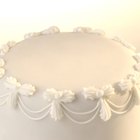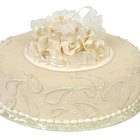
While all icings add sweetness, there are a lot of different types of icings and each one has its purpose. While buttercream and royal icing are both used to decorate cakes, they’re barely interchangeable. Each type of frosting can bring a little more to the decorating table and make your job easier -- as long as they’re used properly.
Ingredients
Royal icing is made from powdered sugar, meringue powder and water. You can add extracts or flavorings, but typically it’s not required. Buttercream is made from powdered sugar, butter or shortening, milk or cream and an extract. Unlike royal icing, buttercream can also turn into a chocolate frosting using cocoa powder or real, melted chocolate.
Taste
Royal icing is extremely sweet, since it’s made from a large content of powdered sugar. Buttercream, on the other hand, has a buttery, creamy taste to it and it takes well to extracts or additional flavors -- like citrus peel.
Consistency
Buttercream offers a soft, smooth and spreadable consistency that works well for covering cakes or piping over cupcakes. While it does dry on the surface, buttercream remains soft underneath that hardened crust. Royal icing is thin and stiff after it’s prepared and it dries to a hard, solid consistency once used.
Use
Both icings can be used on cupcakes, cakes and cookies, but each has a different purpose. Buttercream is used to decorate cakes and cupcakes and is the primary glue used between a layer of fondant and cake. Royal icing is not used to cover cakes or cupcakes. Instead, it is best used for piping intricate designs, creating letters, gluing fondant or gum paste decorations to the surface of a cake or for making flowers. Royal icing can be thinned with water and used to coat the exterior of cake pops and cookies, but once royal icing is thinned for this technique it doesn’t dry to a hard, candy-like consistency as it does when it is made normally.
Special Considerations
Royal icing does not handle grease or fats very well. In fact, if your bowls and utensils are not washed properly and the royal icing comes into contact with grease, it will separate and soften. Buttercream is not as finicky as royal icing.
Storage
Royal icing does not need refrigeration to remain fresh. Instead you can store it in an airtight container on the counter for two weeks. Once used to create decorations -- such as flowers, beads or letters -- it can last for a few months at room temperature. Buttercream is made from dairy; therefore it has a shorter shelf life. Unused icing must be stored in the refrigerator in an airtight container for two weeks. Once on a cake, the buttercream can remain in a cool, room temperature environment for two to three days.
Related Articles

The Difference Between Whipped Icing & ...

Do You Need to Refrigerate Whipped ...

Can You Use Heavy Cream When Making ...

Ganache Substitute

Do You Need to Refrigerate Whipped ...

How to Make Frosting Hard for a Cake

How to Make Shiny Icing for Cookies ...

Cupcake Decorating Ideas Without ...

What Happens If Your Fondant Turns Hard?

How to Make a White Decorator Icing

How to Add Meringue Powder to ...

What Do You Use to Make Fondant Stick?

Tips on Using Cream Cheese Icing on a ...

Does Butter Harden After It's Melted?

The Uses for Dry Fondant

How to Store Buttercream Icing

How to Get Buttercream Frosting Stiff

Can I Use Raspberry Jelly as Cake ...

Naked Leather Vs. Cowhide

What Is Dirty Icing in Cake Decorating?
References
Writer Bio
Shailynn Krow began writing professionally in 2002. She has contributed articles on food, weddings, travel, human resources/management and parenting to numerous online and offline publications. Krow holds a Bachelor of Science in psychology from the University of California, Los Angeles and an Associate of Science in pastry arts from the International Culinary Institute of America.
Photo Credits
Jupiterimages/Photos.com/Getty Images